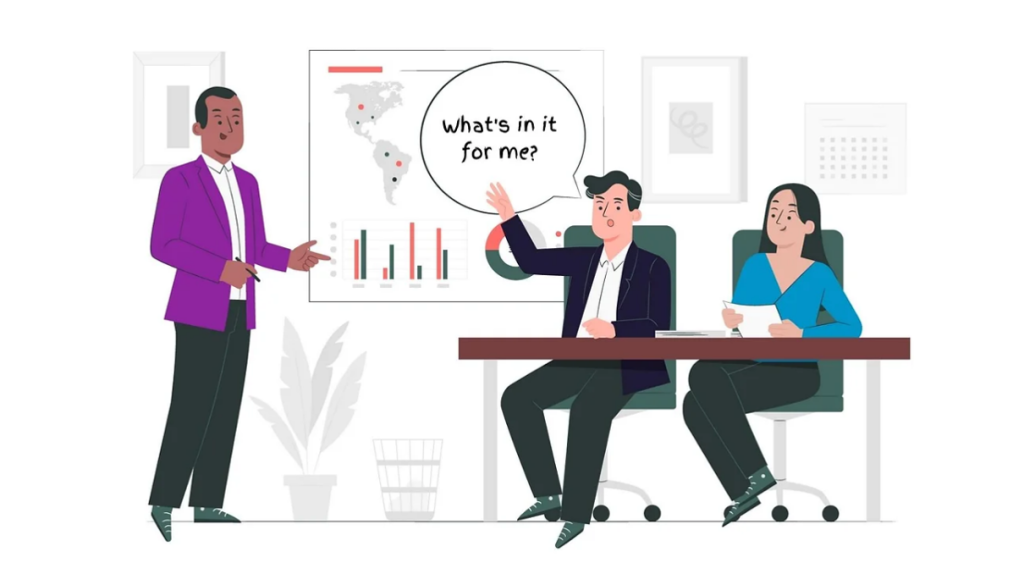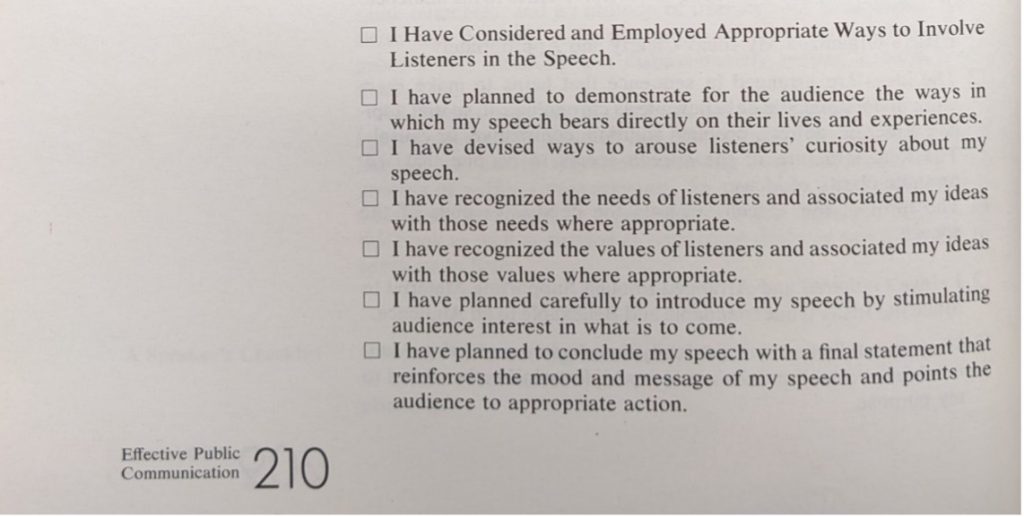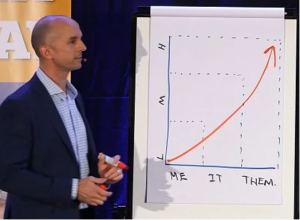Pathos: Establishing WIFM
Beckie Marchessault; Samantha Sentes; and Hoang Nguyen
Introduction
I’m sure many of us have experienced at least one situation in our lives where we find ourselves sitting in a classroom or a boardroom, listening to a lecture or presentation. Halfway through the speech, we start wondering, ‘What is the point of listening to this?’ or ‘Why bother with this?’
As explained in the book Essentials of Public Communications by James R. Andrews (1979), emotions represent strong feelings, awakening us from a detached state during communication. Andrews illustrates this by providing an example of why television commercials for products we couldn’t possibly use or aren’t remotely interested in fail to capture our attention and, consequently, do not motivate us to absorb information or take action.
Additionally, the emphasis in the same book is on using pathos appeal to cater to the audience’s values and needs (Andrews, 1979). From this, Andrews highlights the importance of audience engagement in persuasive speech. That’s why applying pathos appeal and establishing “What’s In It For Me” (WIFM or WIIFM) is crucial.
To understand how WIFM can benefit us in public speaking, let’s delve into the rhetorical theory that supports it.
Application of Rhetorical Theory
Bitzer’s Rhetorical Situation
As defined by Lloyd Bitzer (1980), the rhetorical situation is a specific combination of three elements: rhetorical exigence, rhetorical audience, and constraints. In a way, a persuasive speech contains the rhetorical exigence (what you want to change), your rhetorical audience (people who are capable of positively modifying what you want to change), and the constraints (what stops them from doing so). By understanding the constraints and answering the question “What is in it for [the audience]?” we can tailor the message specifically to our targeted audience to persuade them to take action. This leads to the next rhetorical theory of modes of appeals.
Aristotle and the Three Modes of Appeal
Aristotle was a Greek philosopher that studied and wrote about a wide range of subjects, including rhetoric between 367 and 347 BC.
Rhetoric is the art of persuasion, and persuasion is to change another’s point of view, or to move them to take an action. According to Aristotle there are three means of persuasion, which include ethos, logos and pathos. Ethos is an appeal to a speaker or writers character. In order to persuade an audience, the speaker has to portray credibility and authority with the audience. Logos is the appeal of reason. The logos appeal is to create a persuasive reason to back up claims made by the speaker or writer. The third mode of appeal which we will be discussing in further detail is pathos. The persuasive appeal of pathos appeals to an audience’s sense of identity, their self-interest and their emotions.
This is a video further explaining the three modes of appeal:
In the YouTube video Ethos, Pathos, Logos by Krista Price, she discusses the importance of the art of persuasion throughout time. She references JFK’s “not what you can do for your country, but what your country can do for you”, as well as many other positive role models using the art of persuasion. Not only did she use positive role models but she also uses example of negative role models using the art of persuasion for evil. The examples she uses are Hitler, Stalin, and Jim Jones negative roles leading many people to their deaths. She then explains the importance of the three modes of appeal in the art of persuasion Ethos, Pathos, and Logos into further detail.
Pathos
In The Essential Guide to Rhetoric by Keith and Lundberg (2008), pathos is described as involving the audience’s emotional response to the speaker or speech. Audience members may experience various emotions, such as boredom, annoyance, or excitement, and may have different levels of connection to the topic. Aristotle referred to these emotions as their “state of mind”, which influences how they perceive the arguments presented in the speech and whether they agree with them. Successful speakers aim to align the audience’s emotions with the points they’re making for effective communication.
What’s in it for me is a huge part of a speaker’s pathos appeals. Although it is a large part, it is not the only part. Pathos also includes
- Speaking to, not at the audience
- Establishing common ground
- Recognizing and drawing upon audience needs
- Maintaining eye contact with the audience
Source: RCM 401 Speech Evaluation Form
Pathos really appeals to the audiences’ emotions. It is believed to be one of the strongest of Aristotle’s three modes of appeal. It can be used to arouse anger or to produce action that will benefit somebody. Pathos creates an emotion with words by using a story or description of an event (Henning, 1998).
What’s in it for me?

- Not always about what the audience will get, but about how that audience will feel
- Inspiring the audience to do something
- Way for people to make decisions
- Trust
That question drives most every decision you make. From the moment you wake up in the morning, “What’s in it for me” is the subconscious mantra playing quietly in the back of your head. These five words help you choose what clothes to wear, what food to eat, what people to hang around with, what movie to watch, and so on. They also help you evaluate risks: do you dare walk across that fallen log, do you try to make that traffic light, do you ask for a raise, do you ask her out, do you get a Bald Eagle, do you find a new job, do I go on with these examples, do I write do I go on with these examples….? (Martin, 2004).
Analyzing WIFM
Obama Speech — “Inauguration 2013: Highlights From Obama’s Speech”
President Obama does a great job of using Aristotle’s three modes of appeal. In this speech in particular he uses incredible pathos appeals and influences the audiences’ emotions. Some notable Pathos appeals are “What’s in it for me” (WIFM).
As we have already discussed to establish WIFM you must establish common ground and draw upon the audience’s needs. The president does this in the speech in many ways. The first would be when he stated that the war was ending. Although this issue was strongly divided in the United States, the American audience could have a lot to gain out of it. Some would have friends and family coming back, while others would be more concerned about the tax money that would be saved from not being at war.
Another point President Obama mentioned was that there would be a reduction in the cost of health care and the size of the deficit. Many Americans would be better off if they have cheaper health care and that is a huge WIFM appeal to them as well as their families. Reducing the size of the deficit would benefit most Americans by having a more stable stronger country financially.
The last point that he mentioned was that he is going to try his best to create equality for all people especially the gay community. This appeals to a lot of people and equality has always been a constant struggle for many Americans. If you are a part of the gay community, you would gain a lot from equality of right and other things such as marriage. Although equality for everyone seems like a distant dream for most the president is trying to make it a reality.
Trump Encourages Those At His Rally To March To The Capitol
In contrast to the previous example, let’s consider Trump’s infamous speech in 2021 delivered in front of the Ellipse, which incited and led to the January 6 United States Capitol attack by his supporters. Setting aside political biases, let’s focus solely on the use of pathos in his speech.
Trump established common ground with his supporters by voicing his belief that he lost the election due to “stolen votes” and demanding Congress to “recount.” He then utilized pathos to inflame his supporters’ emotions, urging them to take action by declaring, “After this, we’re going to walk down [to the Capitol], and I’ll be there with you.” Trump’s wording implied his support for the march.
Furthermore, he appealed to his supporters’ value of strength by stating, “Because you’ll never take back our country with weakness, you have to show strength, and you have to be strong.” (Trump Encourages Those At His Rally To March To The Capitol | NBC News NOW, 2021) The events that followed became known as the January 6 United States Capitol attack.
This example illustrates the unethical use of pathos and WIFM to manipulate and incite emotions, showcasing the potent effect of pathos in influencing and persuading audiences to take action.
How do I establish WIFM?
Develop a speech strategy and checklist

Checklist: In the book Essentials of Public Communication by James Andrews (1979), the author created a speaker checklist that we should prepare before our speech, aligning with our speech strategies. The figure below is a condensed version of the checklist, focusing on pathos appeals, connecting with the audience, and establishing WIFM.

Energy: According to Benjamin Harvey (2019), audiences often fail to recall the presenter or the presentation itself due to studies showing that our memory prioritizes information based on personal relevance. Thus, he introduces a strategy known as the ‘WIFM arc of energy,’ which entails commencing with low energy to establish personal credibility, gradually increasing energy while addressing the issue, and concluding with high energy to emphasize audience benefit.

By adhering to this approach, speakers can sustain audience engagement and ensure retention of key points, effectively embedding different aspects of the presentation in the audience’s mind at various energy levels.

